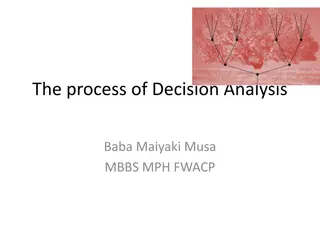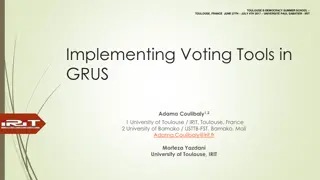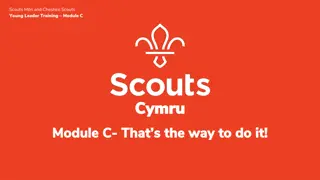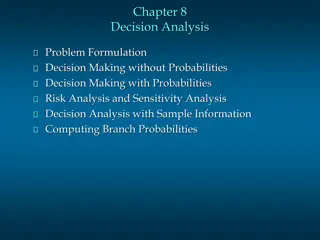
Decision-Making Styles and Team Roles
Explore different decision-making styles, their pros and cons, and how to choose the right style for a given situation. Learn when to engage the team and understand the determinants of decision-making styles.
Download Presentation

Please find below an Image/Link to download the presentation.
The content on the website is provided AS IS for your information and personal use only. It may not be sold, licensed, or shared on other websites without obtaining consent from the author. If you encounter any issues during the download, it is possible that the publisher has removed the file from their server.
You are allowed to download the files provided on this website for personal or commercial use, subject to the condition that they are used lawfully. All files are the property of their respective owners.
The content on the website is provided AS IS for your information and personal use only. It may not be sold, licensed, or shared on other websites without obtaining consent from the author.
E N D
Presentation Transcript
Decision-making styles and role of the team Objectives: Understand different decision making styles Pros and cons of each decision making style The right decision-making style in a given situation When to engage the team
What Is Decision Making? Decision making refers to making choices among alternative courses of action which may also include inaction.
What determines Decision-Making Styles? Two spectrums work together to create the decision-making style framework. 1. structure vs. ambiguity. This spectrum measures propensity to prefer either structure (i.e., defined expectations) or ambiguity (i.e., open- ended and flexible). STRUCTURE Prefer to have a plan, like to have decisions made quickly, experts, practical values people's AMBIGUITY processes and Prefer to keep options open, comfortable with uncertainty, willing to take risks, creative
What determines Decision-Making Styles? 2. task/technical vs. people/social. This spectrum measures if the motivation to make a specific choice is guided more by a desire to be right, or to get results (task/technical), or if it's to create harmony or (people/social). TASK/TECHNICAL Prioritize knowledge, wants best decision to be made even if others agree data and don t PEOPLE /SOCIAL Prioritizes people, seek approval and validation, considers how decisions impact others social impact
If you start using direct decisions to make complex jobs simple, you need to change your approach. Directive decision-making style Typical for internal decision makers Works out the pros and cons of a situation Decisions rooted in their own knowledge, experience, and rationale This style is decision-making is quick, ownership is clear, and requires little communication
When to use it In situations characterized by stability, repeating patterns, and consistent events; Where there is a clear and undisputed cause-and-effect relationship; When there are best practices in place for recurring processes; When leaders have all the required information to make this decision. Communicate in clear, direct language Important! Delegate if necessary
Analytic decision-making style examine much information before taking action rely on direct observation, data, and facts to support their decisions seek information and advice from others to confirm or deny their own knowledge have a high tolerance for ambiguity and are very adaptable can be time-consuming Beware of analysis- paralysis!
When to use it In situations where there may be more than one right answer. to solve problems where the cause-and-effect relationship is discoverable but not immediately apparent to explore several options or solutions and using fact-based management to guide appropriate action consider conflicting advice and ideas openly Important! assemble a team of experts consider the viewpoints of non-experts
Conceptual decision-making style takes a more social approach compared to the directive or analytic methods encourages creative thinking and collaboration and consider a broad array of perspectives achievement-oriented, thinking far into the future Not suitable when a situation needs structure and defined outcomes!
When to use it With problems that involve many competing ideas. situations characterized by unpredictability and suited to creative and innovative approaches When no immediate solution is necessary; It accounts for long-term planning and unknown variables Increase interaction and communication Important! Create groups of people who can contribute innovative ideas Help with the development and delivery of complex decisions
Behavioral decision-making style is group-oriented Instead of brainstorming potential solutions, the group is given the options available to them considers many different outlooks and opinions in the process Change if group discussion sessions never reach an agreement or if new ideas never come up.
When to use it When situation requires proactive communication. When situation requires introspective approach by discussing solutions that have worked in the past rather than trying to reveal new patterns. Open up lines of communication. Create groups of people who can contribute their opinions and encourage democratic discussions. Important! Don t impose a course of action, look at what decision creates the most harmony within the organization.
Engaging the team in decision making Decisions leader makes effect others also their teams. Leaders must make a choice between top-down decision- making approach and a bottom-up one. Which of the 4 decision-making approaches directive decision-making style, consultative style, democratic style, consensus style. Leader-driven decision Employee- driven decision
Directive decision-making style Leader takes the decision unilaterally and communicates it to the team Leader has full control of the decision There is little negotiation. Used for decisions under time-pressure Used when team experience and knowledge Used for non-negotiable decision members lack or no space for top-down The exclusive use of this approach by the leader does not development. The leader should hold a debrief session with the team, if possible. support the team Leader can test it with his trusted partners (manager, peers, HR ) to see their reactions and help preparing answers to possible objections. Probability of having team members not committing or supporting the decision is high.
Consultative decision-making style Team s input is requested; decision is made by the leader. Leader has full control decision, but team members are engaged by sharing their views and opinions. Used when leader needs expertise Used instead of consensus when time is an issue. Used to support team engagement, when team already experience and expertise. of the has some It can lead to long debates. The leader should make it clear that he is the owner of the final decision based on the various individual inputs. Quality objective and frame are not set clearly. of inputs may be low if It has to be made clear how each input has helped to model the decision. Team members must be in a position to bring quality inputs.
Democratic decision-making style Team members and leader provide several alternatives; final decision is based on the result of a vote. This method shifts the power balance to the team final decision may differ from the one proposed by the manager. Used with a team large and mature enough to conclude on several quality proposals. Used to generate participation among the team members It is important that the leader presents the voting method in detail. active For the approach to work, team has to be big enough and have enough experience. All ideas must de allocated same amount of time and attention. Leader has to be comfortable with the fact that his idea might not be picked. Members must be able to accept and work on the idea they might disagree with. Voting parameters have to be clear.
Consensus decision-making style Team members and the leader have to build together a decision that they agree to support. This method allows for team to build and support the decision with almost full autonomy. use with a mature team of experts further commitment and engagement. to create External or recommended especially if topic is sensitive. professional moderator is Team has to be mature enough to discuss and debate without getting to emotional. All must support the decision; the leader must assure it always remains supported. If leader becomes a moderator, he is not no longer neutral, and frustrations. this can cause Time has to be allocated for everyone to share their views. Some team members may act as followers and align their opinions with others. Discussions must remain respectful and constructive.
Reference: Abrioux, Bruno: Effective Decision-Making: when to engage the team (or not)? https://leadersyndrome.wordpress.com/2013/10/13/effective- decision-making-when-to-engage-the-team-or-not/ Malhotra, Sanjay: 4 styles of decision-making: A leader's guide. https://enterprisersproject.com/article/2018/7/4-styles-decision- making-leaders-guide?page=1 Published on: July 27, 2018. Mingail, Harry: Making: Better Decisions: Part 5 Decision Making Style. https://www.youtube.com/watch?v=20BseZ9GHlY Spoelma, Jennifer: Understanding the 4 styles of decision making. https://jenniferspoelma.com/blog-feed/4-styles-decision-making Published on: April 23, 2019






















